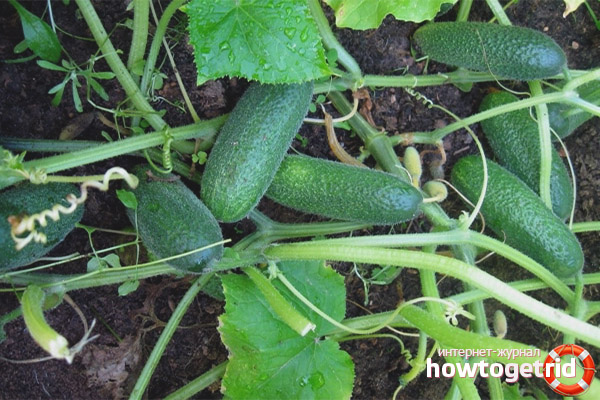The content of the article
Many people like cucumbers. Fresh vegetables are healthy and often used to make salads. Pickled or pickled cucumbers diversify the diet. Ideal for preservation of the gherkin variety. Small fruits are conveniently placed in jars. Variety Salinas refers to just such a species. The variety is distinguished by an early ripening period and a long fruiting period. Designed for cultivation in open beds, as well as in greenhouses and under the film.
Grade characteristics
The Salinas variety is self-pollinating, insect intervention is not required. The first cucumbers can be tasted 40-42 days after the appearance of the sprouts. The bushes are medium-sized, with an average weave. Inflorescences are formed by bunches, from 2 to 4 ovaries are formed in each bunch. Female type flowers.
The shape of the fruit is oval. The skin is dark green with short light stripes along the cucumber. The surface has the presence of small tubercles and white pubescence. The pulp is dense, juicy, crisp, does not contain bitterness. The average mass of cucumber is approximately 90-100 grams. The fruits are short in length, grow from 6 to 9 cm.
Plants tolerate elevated temperatures well, are quite resistant to powdery mildew, cladosporiosis and cucumber mosaic. With good care from one square meter, you can collect 9-10 kg of ripe cucumbers. Fruits tolerate transportation well, therefore, they are often used for transportation over long distances.
Features of cultivation and care
Hybrid is grown in two ways: seedlings and seeds immediately into the soil. Seeds must first be decontaminated. To do this, they are kept for about half an hour in a weak solution of potassium permanganate. After this, the planting material is wrapped in a wet cloth, which is constantly moistened until the seeds hatch.
After the last frost has passed, you can start sowing seeds. The earth must be well warmed up. The optimum temperature is + 10- + 12 degrees. Approximately 30 cm of free space should be left between plants, at least 50 cm between rows. Seeds are laid to a depth of 3-4 cm.
Land for planting cucumbers is prepared in advance. It is necessary to fertilize it with humus or chicken droppings. It is best to apply fertilizer since the fall. After sowing, the beds can be closed with non-woven material. Watering through the material will not erode the earth, and the seeds will receive enough oxygen and moisture.
For seedlings, seeds are sown in containers with light and nutritious soil. The soil can be preliminarily calcined to get rid of possible viruses and pest larvae. To do this, it is placed in an oven or microwave, and heated at high temperature. Then you need to make organic. Good for this purpose is cow manure or bird droppings. Seeds are laid in prepared soil, watered daily. After about a week, the first shoots will appear. Transplanted seedlings to a permanent place, when 4-5 true leaflets are formed on plants.
Care Rules
After planting the seeds and until the end of the fruiting period, the plants should be fed several times with mineral and organic additives. This will well affect the growth and development of the fruit. Especially it is necessary to feed the bushes during flowering and during the period of active fruit ripening. For ease of care, cucumber lashes are tied to a vertical grid or other support. It will also help protect cucumbers from being infected by fungi that develop in the ground.
Water the bushes only with warm, settled water.Cold water can overcool the roots. Watering is recommended in the evening, when the heat subsides or early in the morning, before the heat begins. When watering, you must try not to get on the leaves of plants, but only on the roots. The drip method is preferred. After watering, to enrich the soil with oxygen, you must regularly loosen it. The procedure must be done carefully so as not to damage the root system of plants, which is close to the surface of the earth. Loosening will help to avoid the formation of earth crust. In parallel with loosening, weeds must be periodically removed that draw nutrients from the soil and spread infections.
Pest and Disease Control
Despite its good resistance to diseases and pests, cucumbers can be sprayed with special preparations for prevention. If you regularly inspect the bushes for lesions, then you can immediately take the necessary measures upon detection. Plants can become ill due to non-compliance with care rules. If the bushes are often watered, constantly allowing overmoistening of the soil, then the plants can be affected by root rot.
Pests can be deterred by planting strongly-smelling plants near cucumbers. For example, garlic, dill or onions can be planted between rows of cucumbers. If a spider mite or aphid is found, you can prepare an infusion of onion husks, and spray them with bushes. The same method can be used for prevention.
Reviews gardeners
- Antonina V., 59 years old: Salinas cucumbers are planted specifically for pickling. The care is simple, all the cucumbers are small and taste great. I have been growing these cucumbers for 3 years now. The fruits themselves are tasty, crispy and without a bitter aftertaste. I treat them friends, everyone likes.
- Vladimir F., 65 years old: The first time I planted Salinas cucumber variety this year. Cucumbers are very good. Small, not bitter, great for preparing blanks for the winter. Planted cucumbers in open beds under the film. Harvest got rich. Collected cucumbers until September.
Video: how often and how much to water cucumbers?










Submit